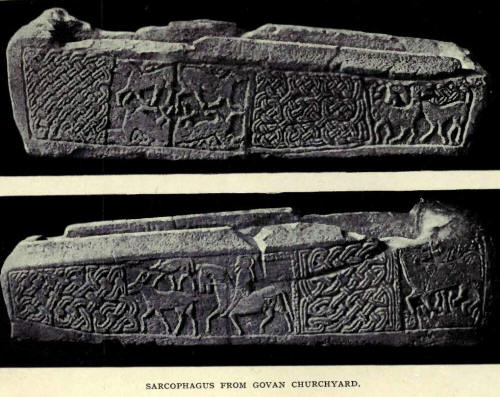|
IN the beginning of
the twelfth century most of the territory surrounding Glasgow, and
extending over Rutherglen, Partick and Govan, formed part of the
royal domain and was probably at the disposal of Prince David as
ruler of the district. Even at that time a considerable population
must have been gathered in the city and adjacent villages, and as
these people would to a large extent depend on the produce of the
soil for their maintenance, it may be assumed that all available
land was cultivated by the class latterly designated Rentallers,
from whom a share of the produce, in name of maul or rent, would be
exacted by the prince and his officers. So much of this land as was
by the inquest ascertained to belong to the church would be under
the same system of management, the only difference being that the
bishop instead of the prince would be overlord and entitled to the
contribution exigible from the tillers of the soil. Split up into
such divisions, the names of these holdings were apparently too
numerous for insertion in the document specifying the result of the
inquiry, and consequently only two or three leading territorial
designations are given, and even these few cannot all be
satisfactorily identified.
About "Pathelanenhc,"
the original name of Provan, there is no doubt. "Cunclut" has
probably a survival in "Kinclayth," a piece of land now incorporated
in Glasgow Green. In his Caledonia, Chalmers gives examples of many
places, both in South and North Britain, having as a compound "Ken,"
"Cyn," or "Kin," signifying first or foremost part, the head, end or
limit. In "Conclut" the second syllable probably indicates Clutha—the
river Clyde—and the whole word, with its prefix of comprehensive
meaning, may be applicable to a large extent of river frontage.
Unless this be so, or unless Partick, bestowed on the church by a
subsequent grant, extended a long way east of the River Kelvin, we
have no certain knowledge how Glasgow Green and a wide stretch of
land to the east and west of that space came into the possession of
the bishopric. But, indeed, it is likely enough that the bishop
obtained large tracts of royal territory without the formality of a
written grant, and even if scrip of some kind passed through the
hands of the prince's officers, the chances are that in many cases
the transactions would neither be registered nor the bits of
parchment preserved. The recorded charters relating to special lands
within the area subsequently known as the Barony of Glasgow are
renewals rather than original grants, and this confirms the
impression that, simultaneously with the reconstitution of the
diocese, the bishop was established as overlord of the city and the
whole of its surrounding lands, both those which had formerly
belonged to the church and the remaining portions from which Prince
David, through his officers, had hitherto derived a share of the
produce.
Of the system under
which these barony lands were cultivated and put to the best avail,
both for overlords and the working community, we have no
contemporary evidence, but it may reasonably be surmised that it was
not essentially different from that which was found in practice in
the sixteenth century, the earliest date of any extant rental books
or rent rolls. The crop-bearing lands would thus be regularly tilled
by a class of rentallers to whom distinct areas would be assigned,
while those lands more suitable for grazing purposes would be

possessed in common,
the inhabitants being entitled to put on cattle or sheep stock in
specified numbers and at prescribed rates. Even in the present day,
after so long a course of drainage and cultivation, there are
several small lochs throughout the barony, and in the twelfth
century patches of stagnant water must have been much more numerous,
and marshy land must have abounded. From such localities, and from
the hilly and rocky ground, with their yield of brushwood, heath,
timber and stone, fuel and building material would be. obtained.
Coal, if used at all, would only be got by quarrying near the
surface, and perhaps the bishops' rentallers would learn that art
from their neighbours in the Monklands, the rentallers of those
monks of Neubotle who have the credit of being the first coalworkers
in Scotland. [Early Scotch History, p. 131.]
At this time, when
the bishop was recognized as overlord of the barony lands, it is
probable that these were subject to certain exactions for the upkeep
of Prince David's establishment at Rutherglen castle. Such at least
is the inference which may be drawn from the terms of an undated
charter of King William (1165-1214) to the effect that after his
accession to the throne King David erected his demesne vill of
Rutherglen into a royal burgh, giving its officers authority to levy
the customs and dues exigible over a wide district, including the
Glasgow area. [A.P.S. i. p. 86. In a supplication to Parliament in
1661 it is stated that King David granted a charter to the burgh of
Rutherglen in 1126 (A.P.S. vii. pp. 239-40).] It may accordingly be
assumed that the bailies of the newly constituted burgh would
continue the collection from the bishop's lands of the customs
hitherto payable, though, as will afterwards be seen, the
establishment of a burgh at Glasgow eventually led to these being
gathered from a restricted area. |

